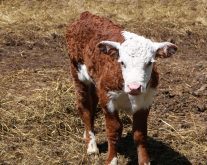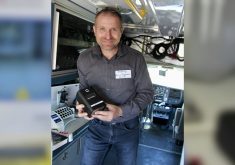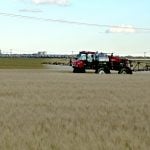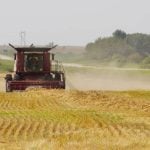Whether she’s working to advance her skills in veterinary medicine or teaching Air Cadets to fly, Ashley Gaudet’s ambition takes her to great heights.
Gaudet, a veterinary technician at Veterinary Agri-Health Services (VAHS) in Airdrie, Alta., grew up in Cornwall, P.E.I. Her family’s neighbours gave her an introduction to agriculture, allowing her to help with their cattle from a young age. They encouraged her to join 4-H and provided her with show calves.
“I participated in 4-H from the age of 11 to 21, showing cattle for them, which eventually led to showing purebreds for their cousins,” she said. “I really just enjoyed working with cattle and working with my hands.”
Read Also

Canadian Beef Check-Off Agency reports on investments and activities
The check-off agency’s work behind the scenes is what ensures cattle check-off dollars are invested wisely, accounted for transparently and deliver measurable value back to producers and importers.
Her neighbours also introduced Gaudet to a future mentor, a friend of theirs who was a veterinarian. “I ended up doing ride-alongs with him and got to show for him as well.”
Gaudet’s ambitious nature propelled her to achievements beyond agriculture. Her father served in the Canadian Forces for 38 years, and Gaudet and her siblings joined the Air Cadet program at the age of 12. “My sister is a reservist in Nova Scotia, my brother is in the regular forces in Gagetown, New Brunswick, and I’m a reservist here in Alberta.”
She obtained her glider pilot’s licence at 16 and private pilot’s licence at 17. “I actually had my pilot’s licence before I had my driver’s licence,” she adds laughing.
She took instructor training at 19 and paid for her post-secondary education by teaching in the summertime. “When I was in college, my classmates were doing co-ops at vet practices, and I was still teaching cadets how to fly.”
Gaudet trained to become a veterinary technician at Oulton College in Moncton, and first came to Alberta for the externship required by this program. After completing her training at the Okotoks Animal Clinic, she returned to the Maritimes to prepare for the exam to become a registered vet technician, a requirement for working in Alberta.
Back in P.E.I., Gaudet took advantage of an opportunity to develop her skills by working at the Atlantic Veterinary College before turning her attention westward. “I knew that this was the industry that I wanted to work in.”
Gaudet officially moved to Alberta in September 2009 and started working at Feedlot Health Management Services in Okotoks. There, she faced a steep learning curve as she immersed herself in the beef industry. “In P.E.I., there’s probably more dairy cows than there are beef, and I had no feedlot experience before working for Feedlot Health.”
Gaudet then became interested in pursuing a veterinary technician specialty in clinical practice. While attending a conference of the American Association of Bovine Practitioners, she learned about a program administered by the Academy of Veterinary Technicians in Clinical Practice for technicians to obtain a special designation.
Obtaining this designation was a two-year process, the first of which was spent collecting 50-70 veterinary cases to report on. Today, her official title is registered veterinary technician with a veterinary technician specialty in clinical practice. She is the only technician in Canada with these credentials.
She completed the course in 2015 and joined VAHS in 2016, a practice that allows her to apply her skills and knowledge to both the cow-calf and feedlot sectors. The vets at the practice refer to her as a technical consultant.
“I’ve got the experience and background that lends me to add value to our practice in ways that were not possible before I pursued this specialty,” she explains.
The future role of vet technicians
While Gaudet contributes more to her practice because of her advanced training, she believes that some vet technicians are not given the chance to do as much as possible, and therein lies an opportunity. “I think technicians are not utilized enough in the large animal side of most veterinary practices,” she said. She explained that she is sometimes referred to as a “super tech,” given her training, but this isn’t unusual. “I’m not an anomaly. I would guess that there are many technicians like me, that have ambitions like me, but they’re not being given the opportunity.”
One such opportunity may be in areas of veterinary medicine that are increasingly carried out by other professionals. “There are tasks that previously were veterinary tasks that are being delegated elsewhere or are being taken over elsewhere.” Farriers, for example, often diagnose and treat lameness, a job traditionally left to veterinarians. Equine dentists do the same thing. “In my mind, this is a great opportunity for large animal practitioners to make more use of those technicians that they already employ.”
Continuing education is a factor she believes helps move technicians in this direction but Gaudet says the Alberta Veterinary Medical Association has trouble generating enough interest to sustain these programs. It’s her hope more veterinarians will recognize the importance of investing in a technician’s continuing education, even if they spend less time on large animals in a mixed practice.
The new regulations requiring producers to have a vet-client relationship to purchase drugs offers another opportunity where technicians can play a role. The relationship must be with the veterinarian, but technicians can help satisfy the requirements for a VCPR. “That’s something we’re doing right now,” she says.
“A huge part has to be the veterinarian, but there is opportunity to have the technician assisting with that, by going through records to find out what products you’ve been using, what your herd size is, what your health concerns are.”
Looking ahead
Gaudet started building a herd of her own last year with the purchase of four commercial females she boards at a friend’s place near Strathmore. She is also gaining practical insights into beef production and business development from mentors Rob and Gail Hamilton of Hamilton Farms at Cochrane, Alta., under the Cattlemen’s Young Leaders program.
Another area of personal interest she’s identified is the contingency planning producers rely on to weather disasters such as BSE. As she puts it, “What do I have to do to ensure a sustainable herd and to overcome adversity?”
Her plan is to increase her herd over time to something near the Canadian average herd size of 60 head. “That’s the number that I have in my head right now that I’m actively building up to.” She’ll likely become more involved in the purebred sector, as well.
When it comes to where her career will take her, Gaudet continues to dream big and has set her sights on managing a practice in the future. At the moment, she is taking an online certificate program in veterinary practice management offered through Olds College.
She also wants to help establish an organization for veterinary technicians. “It’s actually a dream of mine, to have an association or to make an association for food animal technicians.”

















